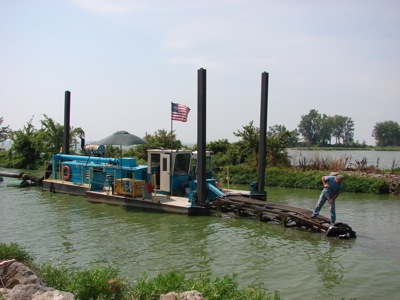Friday, September 14th, 2007
Dredging a never-ending job
By Janie Southard

Photo by Janie Southard/The Daily Standard
State park dredge operator Gary Pittard works in the yacht club channel on the state's dredge, Pump-a-Little, cleaning out a path for the sailboats to get on the lake. The channel was more than 50 percent clogged with sediment.
St. MARYS - It's sometimes a challenge to get a boat onto Grand Lake due to any number of factors not excluding no cooperation from your crew. But for sailboat owners going out the channel at the St. Marys Yacht Club, the journey out just got easier.
The state park's floating suction dredge, dubbed the Pump-a-Little, was locked onto the yacht club channel a couple weeks ago, sucking out sediment that was clogging more than 50 percent of it. The work is part of an old memorandum of understanding between the state and the club regarding the periodic cleaning of the channel.
In exchange for the club's maintenance of the state docks, the state dredges the channel.
"It was down to only a little over 2 feet of water, and more than half these (deep keel) boats couldn't get out on the lake," state park Manager Craig Morton said while at the sailboat channel as the small dredge chugged along with its snout buried in the water.
He said the operation should be done at least every 10 years and more frequently if possible. The sailboat channel hasn't been dredged in almost five years and was more than due.
"The lake channels fill (with sediment) due to wind and wave action ... Right now, there's only a small flow of water here," he said.
Morton described the dredging operation: The dredge is a floating barge with a boom in front that scans the channel bottom in a pendulum motion. On the end of the boom is a cutterhead, which rotates constantly, disturbing the sediment.
A pump sucks the sediment into a long pipeline, maybe a foot in diameter, and deposits it onto a spoil site, more accurately referred to as a dredge material relocation area. In this case, it's at a peninsula point behind the park office.
The pipeline contains about 20 percent mud and 80 percent water. At the spoil area, the material is left to settle until the water drains away. What is left makes a rich soil, which the park makes available to local landscapers and contractors.
Getting the dredge material to the rich soil stage is labor-intensive, according to Morton.
"You have to drain the water off and dry the material off. It takes time," Morton said, indicating a pond of slurry-looking goop and an adjacent mound of dark brown-black soil on a peninsula behind the park office.
Whenever possible and necessary, a large rock barge anchors between the little dredge and the open lake as a precaution.
"It's about safety ... We don't want boaters injured because they did not recognize (what the little barge is actually doing) ... And, yes, the rock barge is also used for shooting fireworks at the Lake Festival," the park manager said.
The constant need for dredging is typical of all canal lakes because they were dug in wetland areas on highly erodable soil, Morton explained.
After the little dredge finished the sailboat channel, it moved on to its next project near Duckfoot Landing, but moving is not as easy as it would appear.
"People think we can just move it across the lake anytime we want, but we have to be really careful. A couple good waves could easily sink it. If it's a windy day we don't even think of moving it," he said of the floating dredge whose replacement cost would be more than $500,000.




